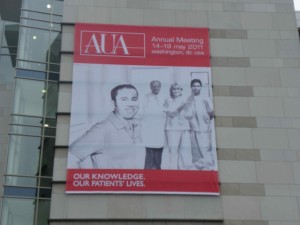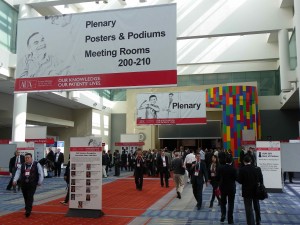AUA 2011 European men with a biochemical recurrence have a lower prostate cancer survival compared to the United States
 One of the sessions that I attended at the 2011 annual meeting of the American Urological Association (AUA) focused on research into advanced prostate cancer. A particularly thought provoking presentation was:
One of the sessions that I attended at the 2011 annual meeting of the American Urological Association (AUA) focused on research into advanced prostate cancer. A particularly thought provoking presentation was:
Time trends of biochemical recurrence (BCR) following radical prostatectomy (RP) among 1574 BCR patients (Abstract #639)
 Presented by Alex Haese from Hamburg, Germany, this paper was a retrospective analysis of 1,574 patients who had a biochemical recurrence (PSA > 0.2 mg/dl) following RP. Researchers looked at clinical progression and cancer specific survival rates and compared their findings to published United States data.
Presented by Alex Haese from Hamburg, Germany, this paper was a retrospective analysis of 1,574 patients who had a biochemical recurrence (PSA > 0.2 mg/dl) following RP. Researchers looked at clinical progression and cancer specific survival rates and compared their findings to published United States data.
The results appeared to be somewhat depressing for European patients who experience a BCR, with a time to BCR of 1.8 years, compared to 2.1 years in the US research by Pound from Johns Hopkins and 2.4 years in the data published by Hull, at Memorial Sloan Kettering Cancer Center (MSKCC).
Once a BCR is experienced, the time to metastases is faster in Europe, 4.7 years in the research presented by Haese at AUA, as compared to 8 years in US research by Pound. Risk factors for metastasis free survival include time to BCR i.e.
“The longer the interval between RP and BCR, the greater the probability of being met-free.”
In other words delaying time to progression is associated with longer survival.
Following BCR, time to Prostate Cancer death was 6.0 years in the 1,574 European patients, compared to 13 years in the US Pound research. Again, the data presented showed that,
“The longer the interval between RP and BCR, the greater the probability of being alive.”
This research must be put into context, as metastasis and death in BCR patients are rare (92% of the 1,574 patients with BCR were free of metastases at 5 years, 81% at 10 years). However, for those patients who did progress, the results appear significantly different between the US and Europe.
What could explain this?
The presentation left this question unanswered, although in Q&A it was briefly touched upon. One person raised the question of whether differences in screening could be the difference in Europe vs. US?
Other questions that come to mind are whether the subject populations in the Hull and Pound data were comparable. The German data also had more patients (1574) compared to 304 in the Pound research and 147 (Hull) raising the question that the larger sample size may be more accurate data?
Other factors that might possibly explain the difference include:
- Androgen deprivation therapy (ADT)
- Radiotherapy
- Supportive care (eg bisphosphonates)
All of which tend to be more aggressively pursued as treatment options in the USA.
Overall, this presentation raised the interesting question of US/European differences in Prostate Cancer progression that hopefully will be answered by future research.
 There is a lot of focus at the
There is a lot of focus at the 
